warning light RENAULT SCENIC 2009 J84 / 2.G Engine And Peripherals EDC16 Workshop Manual
[x] Cancel search | Manufacturer: RENAULT, Model Year: 2009, Model line: SCENIC, Model: RENAULT SCENIC 2009 J84 / 2.GPages: 273
Page 10 of 273
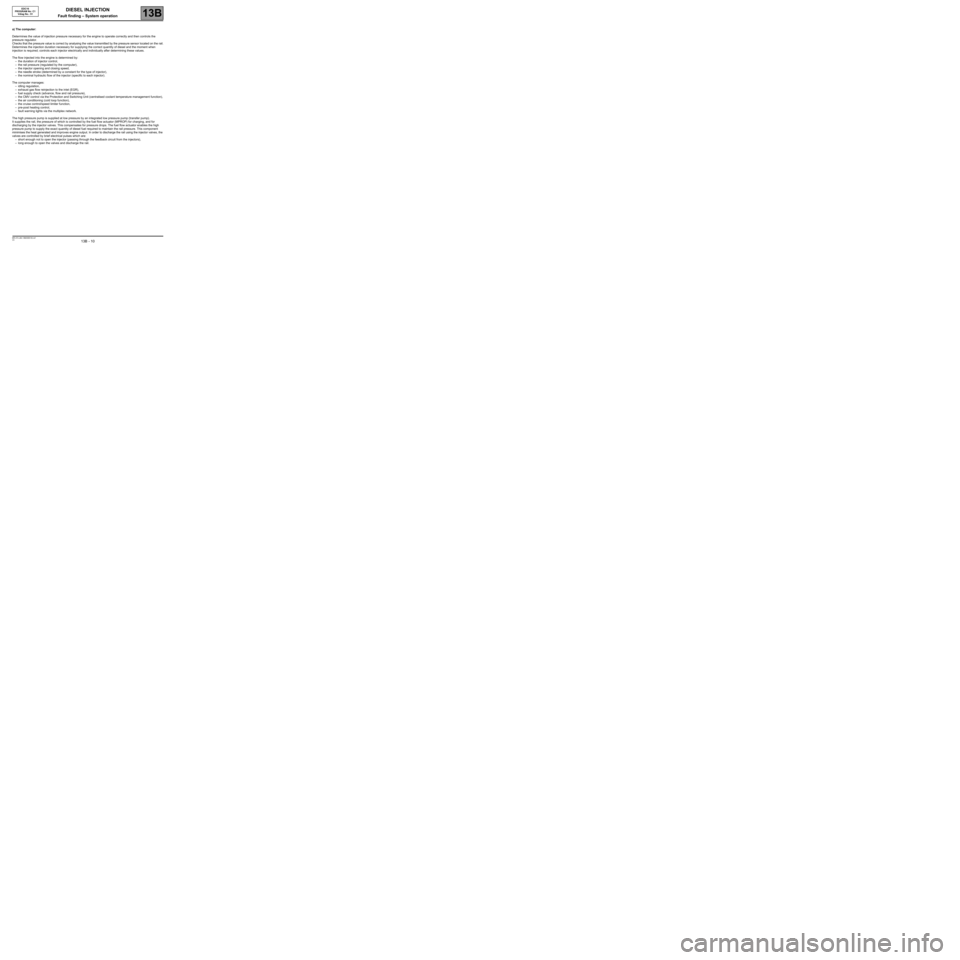
DIESEL INJECTION
Fault finding – System operation13B
13B - 10V3 MR-372-J84-13B250$135.mif
EDC16
PROGRAM No: C1
Vdiag No.: 51
a) The computer:
Determines the value of injection pressure necessary for the engine to operate correctly and then controls the
pressure regulator.
Checks that the pressure value is correct by analysing the value transmitted by the pressure sensor located on the rail.
Determines the injection duration necessary for supplying the correct quantity of diesel and the moment when
injection is required; controls each injector electrically and individually after determining these values.
The flow injected into the engine is determined by:
–the duration of injector control,
–the rail pressure (regulated by the computer),
–the injector opening and closing speed,
–the needle stroke (determined by a constant for the type of injector),
–the nominal hydraulic flow of the injector (specific to each injector).
The computer manages:
–idling regulation,
–exhaust gas flow reinjection to the inlet (EGR),
–fuel supply check (advance, flow and rail pressure),
–the CMV control via the Protection and Switching Unit (centralised coolant temperature management function),
–the air conditioning (cold loop function),
–the cruise control/speed limiter function,
–pre-post heating control,
–fault warning lights via the multiplex network.
The high pressure pump is supplied at low pressure by an integrated low pressure pump (transfer pump).
It supplies the rail, the pressure of which is controlled by the fuel flow actuator (MPROP) for charging, and for
discharging by the injector valves. This compensates for pressure drops. The fuel flow actuator enables the high
pressure pump to supply the exact quantity of diesel fuel required to maintain the rail pressure. This component
minimises the heat generated and improves engine output. In order to discharge the rail using the injector valves, the
valves are controlled by brief electrical pulses which are:
–short enough not to open the injector (passing through the feedback circuit from the injectors),
–long enough to open the valves and discharge the rail.
Page 11 of 273
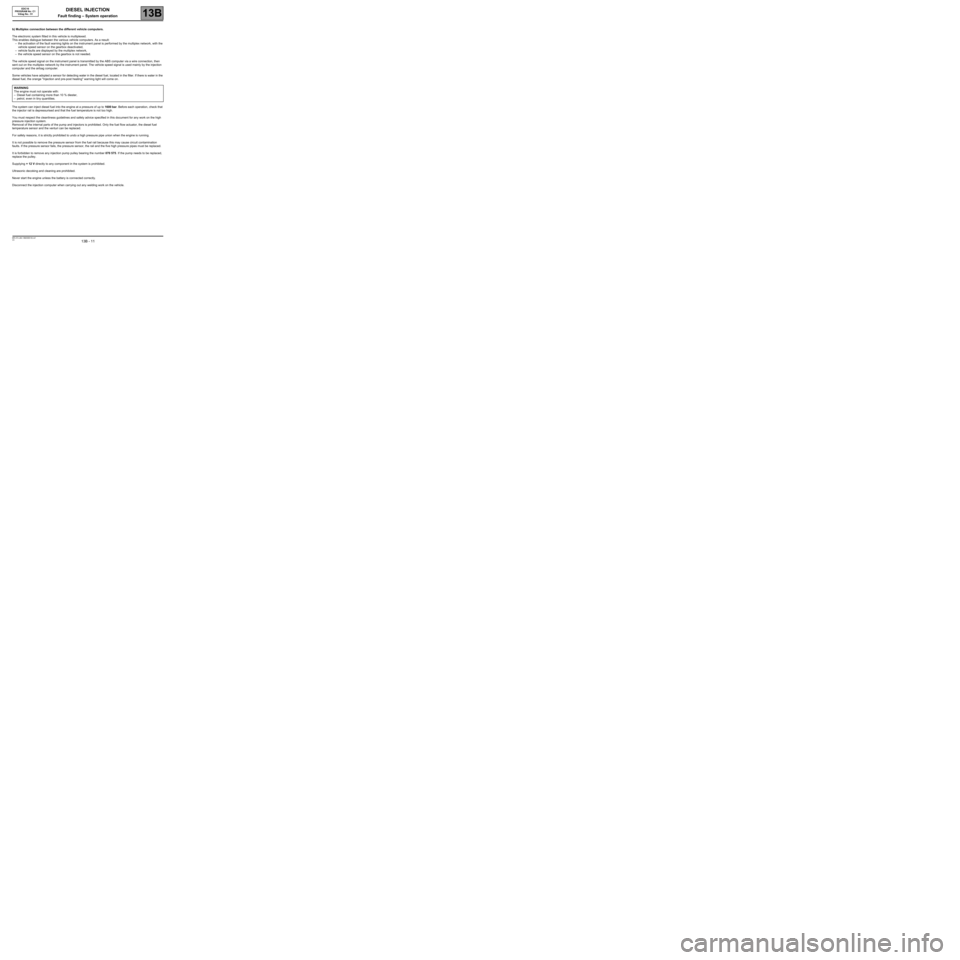
DIESEL INJECTION
Fault finding – System operation13B
13B - 11V3 MR-372-J84-13B250$135.mif
EDC16
PROGRAM No: C1
Vdiag No.: 51
b) Multiplex connection between the different vehicle computers.
The electronic system fitted in this vehicle is multiplexed.
This enables dialogue between the various vehicle computers. As a result:
–the activation of the fault warning lights on the instrument panel is performed by the multiplex network, with the
vehicle speed sensor on the gearbox deactivated,
–vehicle faults are displayed by the multiplex network,
–the vehicle speed sensor on the gearbox is not needed.
The vehicle speed signal on the instrument panel is transmitted by the ABS computer via a wire connection, then
sent out on the multiplex network by the instrument panel. The vehicle speed signal is used mainly by the injection
computer and the airbag computer.
Some vehicles have adopted a sensor for detecting water in the diesel fuel, located in the filter. If there is water in the
diesel fuel, the orange "Injection and pre-post heating" warning light will come on.
The system can inject diesel fuel into the engine at a pressure of up to 1600 bar. Before each operation, check that
the injector rail is depressurised and that the fuel temperature is not too high.
You must respect the cleanliness guidelines and safety advice specified in this document for any work on the high
pressure injection system.
Removal of the internal parts of the pump and injectors is prohibited. Only the fuel flow actuator, the diesel fuel
temperature sensor and the venturi can be replaced.
For safety reasons, it is strictly prohibited to undo a high pressure pipe union when the engine is running.
It is not possible to remove the pressure sensor from the fuel rail because this may cause circuit contamination
faults. If the pressure sensor fails, the pressure sensor, the rail and the five high pressure pipes must be replaced.
It is forbidden to remove any injection pump pulley bearing the number 070 575. If the pump needs to be replaced,
replace the pulley.
Supplying + 12 V directly to any component in the system is prohibited.
Ultrasonic decoking and cleaning are prohibited.
Never start the engine unless the battery is connected correctly.
Disconnect the injection computer when carrying out any welding work on the vehicle.WARNING
The engine must not operate with:
–Diesel fuel containing more than 10 % diester,
–petrol, even in tiny quantities.
Page 14 of 273
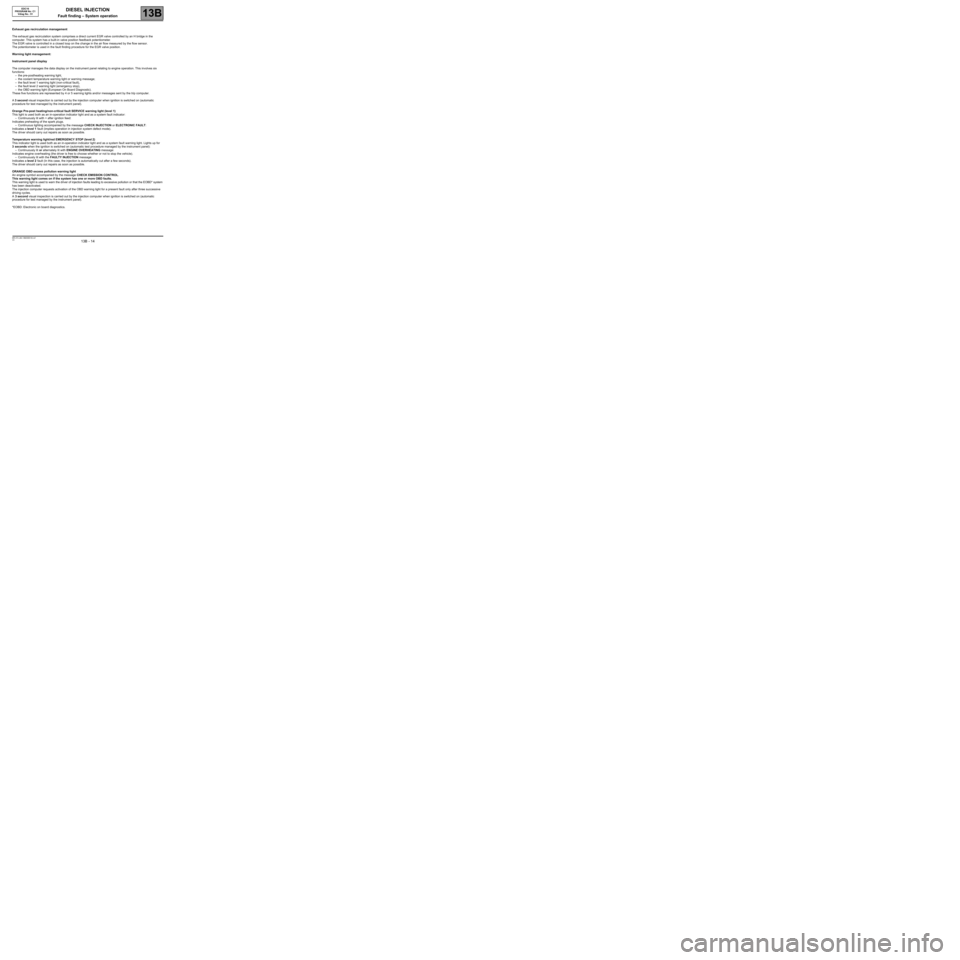
DIESEL INJECTION
Fault finding – System operation13B
13B - 14V3 MR-372-J84-13B250$135.mif
EDC16
PROGRAM No: C1
Vdiag No.: 51
Exhaust gas recirculation management
The exhaust gas recirculation system comprises a direct current EGR valve controlled by an H bridge in the
computer. This system has a built-in valve position feedback potentiometer.
The EGR valve is controlled in a closed loop on the change in the air flow measured by the flow sensor.
The potentiometer is used in the fault finding procedure for the EGR valve position.
Warning light management:
Instrument panel display
The computer manages the data display on the instrument panel relating to engine operation. This involves six
functions:
–the pre-postheating warning light,
–the coolant temperature warning light or warning message;
–the fault level 1 warning light (non-critical fault),
–the fault level 2 warning light (emergency stop),
–the OBD warning light (European On Board Diagnostic).
These five functions are represented by 4 or 5 warning lights and/or messages sent by the trip computer.
A 3 second visual inspection is carried out by the injection computer when ignition is switched on (automatic
procedure for test managed by the instrument panel).
Orange Pre-post heating/non-critical fault SERVICE warning light (level 1)
This light is used both as an in-operation indicator light and as a system fault indicator:
–Continuously lit with + after ignition feed:
Indicates preheating of the spark plugs.
–Continuous lighting accompanied by the message CHECK INJECTION or ELECTRONIC FAULT:
Indicates a level 1 fault (implies operation in injection system defect mode).
The driver should carry out repairs as soon as possible.
Temperature warning light/red EMERGENCY STOP (level 2)
This indicator light is used both as an in-operation indicator light and as a system fault warning light. Lights up for
3 seconds when the ignition is switched on (automatic test procedure managed by the instrument panel):
–Continuously lit or alternately lit with ENGINE OVERHEATING message:
Indicates engine overheating (the driver is free to choose whether or not to stop the vehicle).
–Continuously lit with the FAULTY INJECTION message:
Indicates a level 2 fault (In this case, the injection is automatically cut after a few seconds).
The driver should carry out repairs as soon as possible.
ORANGE OBD excess pollution warning light
An engine symbol accompanied by the message CHECK EMISSION CONTROL.
This warning light comes on if the system has one or more OBD faults.
This warning light is used to warn the driver of injection faults leading to excessive pollution or that the EOBD* system
has been deactivated.
The injection computer requests activation of the OBD warning light for a present fault only after three successive
driving cycles.
A 3 second visual inspection is carried out by the injection computer when ignition is switched on (automatic
procedure for test managed by the instrument panel).
*EOBD: Electronic on board diagnostics.
Page 15 of 273
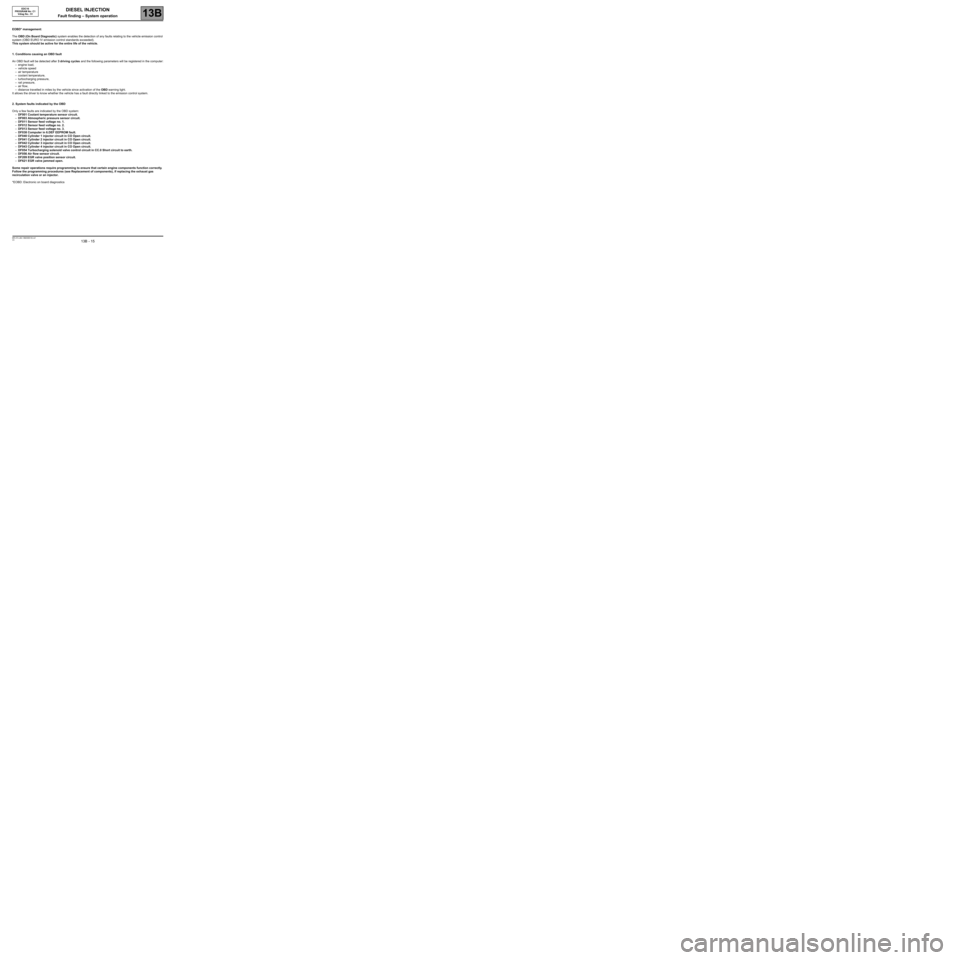
DIESEL INJECTION
Fault finding – System operation13B
13B - 15V3 MR-372-J84-13B250$135.mif
EDC16
PROGRAM No: C1
Vdiag No.: 51
EOBD* management:
The OBD (On Board Diagnostic) system enables the detection of any faults relating to the vehicle emission control
system (OBD EURO IV emission control standards exceeded).
This system should be active for the entire life of the vehicle.
1. Conditions causing an OBD fault
An OBD fault will be detected after 3 driving cycles and the following parameters will be registered in the computer:
–engine load,
–vehicle speed
–air temperature
–coolant temperature,
–turbocharging pressure,
–rail pressure,
–air flow,
–distance travelled in miles by the vehicle since activation of the OBD warning light.
It allows the driver to know whether the vehicle has a fault directly linked to the emission control system.
2. System faults indicated by the OBD
Only a few faults are indicated by the OBD system:
–DF001 Coolant temperature sensor circuit.
–DF003 Atmospheric pressure sensor circuit.
–DF011 Sensor feed voltage no. 1.
–DF012 Sensor feed voltage no. 2.
–DF013 Sensor feed voltage no. 3.
–DF038 Computer in 6.DEF EEPROM fault.
–DF040 Cylinder 1 injector circuit in CO Open circuit.
–DF041 Cylinder 2 injector circuit in CO Open circuit.
–DF042 Cylinder 3 injector circuit in CO Open circuit.
–DF043 Cylinder 4 injector circuit in CO Open circuit.
–DF054 Turbocharging solenoid valve control circuit in CC.0 Short circuit to earth.
–DF056 Air flow sensor circuit.
–DF209 EGR valve position sensor circuit.
–DF621 EGR valve jammed open.
Some repair operations require programming to ensure that certain engine components function correctly.
Follow the programming procedures (see Replacement of components), if replacing the exhaust gas
recirculation valve or an injector.
*EOBD: Electronic on board diagnostics
Page 16 of 273
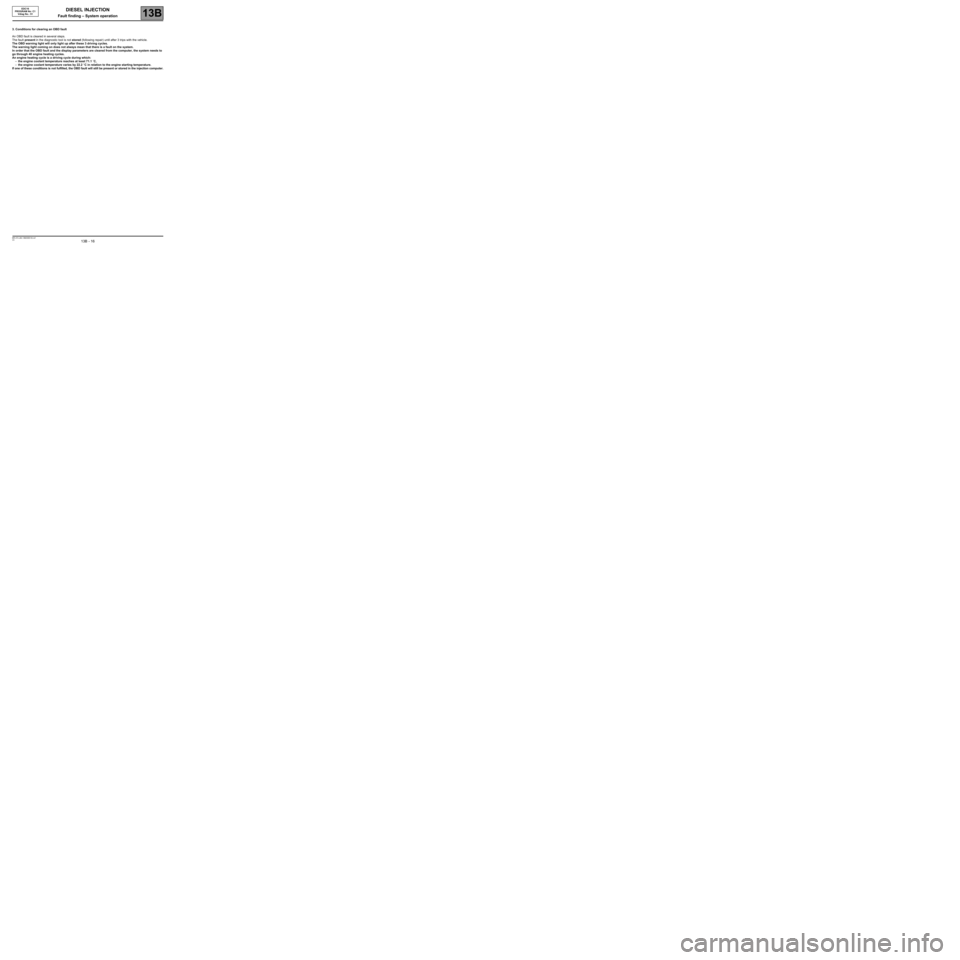
DIESEL INJECTION
Fault finding – System operation13B
13B - 16V3 MR-372-J84-13B250$135.mif
EDC16
PROGRAM No: C1
Vdiag No.: 51
3. Conditions for clearing an OBD fault
An OBD fault is cleared in several steps.
The fault present in the diagnostic tool is not stored (following repair) until after 3 trips with the vehicle.
The OBD warning light will only light up after these 3 driving cycles.
The warning light coming on does not always mean that there is a fault on the system.
In order that the OBD fault and the display parameters are cleared from the computer, the system needs to
go through 40 engine heating cycles.
An engine heating cycle is a driving cycle during which:
–the engine coolant temperature reaches at least 71.1 ˚C,
–the engine coolant temperature varies by 22.2 °C in relation to the engine starting temperature.
If one of these conditions is not fulfilled, the OBD fault will still be present or stored in the injection computer.
Page 26 of 273
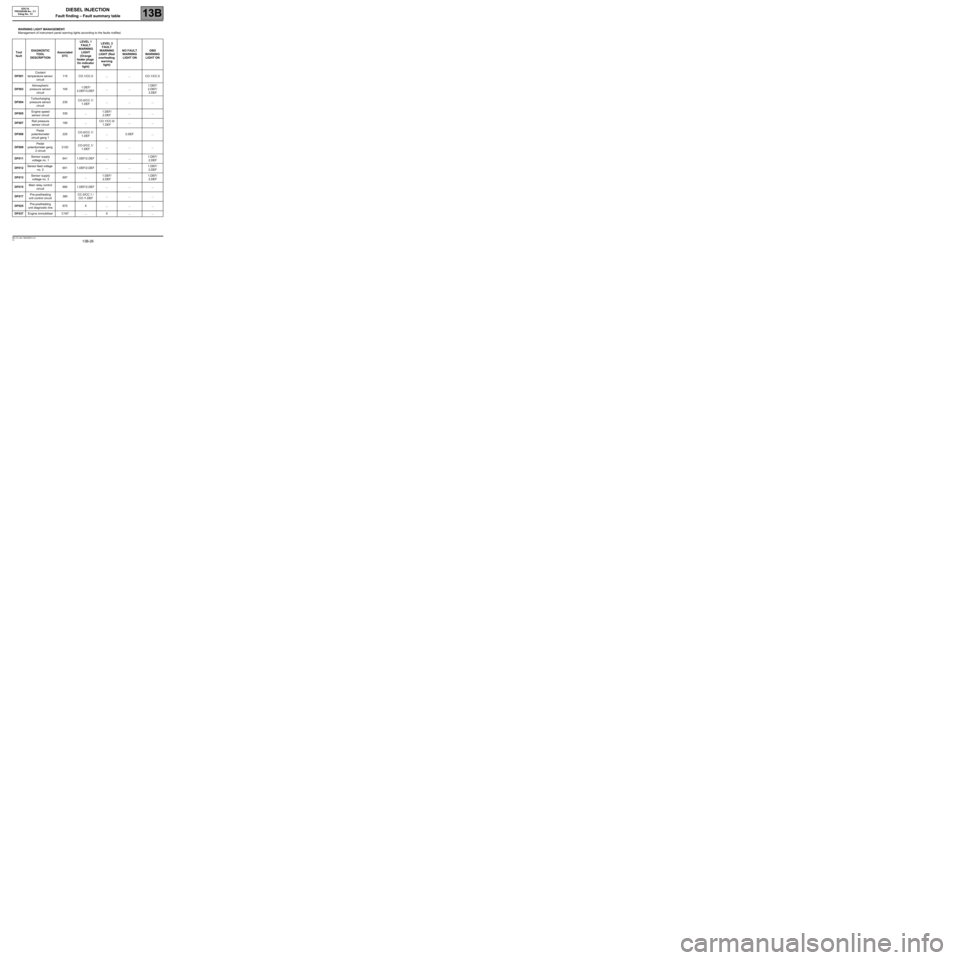
DIESEL INJECTION
Fault finding – Fault summary table13B
13B-26V3 MR-372-J84-13B250$270.mif
EDC16
PROGRAM No.: C1
Vdiag No.: 51DIESEL INJECTION
Fault finding – Fault summary table
WARNING LIGHT MANAGEMENT:
Management of instrument panel warning lights according to the faults notified.
Tool
faultDIAGNOSTIC
TOOL
DESCRIPTIONAssociated
DTCLEVEL 1
FAULT
WARNING
LIGHT
(Orange
heater plugs
On indicator
light)LEVEL 2
FAULT
WARNING
LIGHT (Red
overheating
warning
light)NO FAULT
WARNING
LIGHT ONOBD
WARNING
LIGHT ON
DF001Coolant
temperature sensor
circuit115 CO.1/CC.0 ... ... CO.1/CC.0
DF003Atmospheric
pressure sensor
circuit1051.DEF/
2.DEF/3.DEF... ...1.DEF/
2.DEF/
3.DEF
DF004Turbocharging
pressure sensor
circuit235CO.0/CC.1/
1.DEF... ... ...
DF005Engine speed
sensor circuit335 ...1.DEF/
2.DEF... ...
DF007Rail pressure
sensor circuit190 ...CO.1/CC.0/
1.DEF... ...
DF008Pedal
potentiometer
circuit gang 1225CO.0/CC.1/
1.DEF... 2.DEF ...
DF009Pedal
potentiometer gang
2 circuit2120CO.0/CC.1/
1.DEF... ... ...
DF011Sensor supply
voltage no. 1641 1.DEF/2.DEF ... ...1.DEF/
2.DEF
DF012Sensor feed voltage
no. 2651 1.DEF/2.DEF ... ...1.DEF/
2.DEF
DF013Sensor supply
voltage no. 3697 ...1.DEF/
2.DEF...1.DEF/
2.DEF
DF015Main relay control
circuit685 1.DEF/2.DEF ... ... ...
DF017Pre-postheating
unit control circuit380CC.0/CC.1 /
CO /1.DEF... ... ...
DF025Pre-postheating
unit diagnostic line670 X ... ... ...
DF037Engine immobiliser C167 ... X ... ...
Page 27 of 273

DIESEL INJECTION
Fault finding – Fault summary table13B
13B-27V3 MR-372-J84-13B250$270.mif
EDC16
PROGRAM No.: C1
Vdiag No.: 51
Tool
faultDIAGNOSTIC
TOOL
DESCRIPTIONAssociated
DTCLEVEL 1 FAULT
WARNING
LIGHT (Orange
heater plugs On
indicator light)LEVEL 2 FAULT
WARNING
LIGHT (Red
overheating
warning light)NO
FAULT
WARNING
LIGHT ONOBD
WARNING
LIGHT ON
DF038Computer 6066.DEF/8.DEF/
12.DEF1.DEF/2.DEF/
3.DEF/4.DEF/
5.DEF/7.DEF/
10.DEF/11.DEF/
13.DEF/14.DEF... 6.DEF
DF039Inlet air
temperature
sensor circuit110 ... CC.0/CO.1 ... ...
DF040Cylinder 1
injector circuit201 CO CC.1/CC/1.DEF ... CO
DF041Cylinder 2
injector circuit202 CO CC.1/CC/1.DEF ... CO
DF042Cylinder 3
injector circuit203 CO CC.1/CC/1.DEF ... CO
DF043Cylinder 4
injector circuit204 CO CC.1/CC/1.DEF ... CO
DF046Battery voltage 560 ... ...1.DEF/
2.DEF...
DF047Computer feed
voltage615 ... ... 1.DEF ...
DF049Refrigerant
sensor circuit530 ... ... CC.1/CO.0 ...
DF050Brake switch
circuit571 ... ...1.DEF/
2.DEF...
DF051Cruise control/
speed limiter
function575 ... ...1.DEF/
2.DEF/
3.DEF...
DF053Rail pressure
regulation
function89 3.DEFCC.0/CC.1/CO/
1.DEF/2.DEF/
4.DEF/5.DEF/
6.DEF/7.DEF... ..
DF054Turbocharging
solenoid valve
control circuit33CO/CC.0/CC.1/
1.DEF/2.DEF/
3.DEF/4.DEF/
5.DEF... ... CC.0
Page 28 of 273
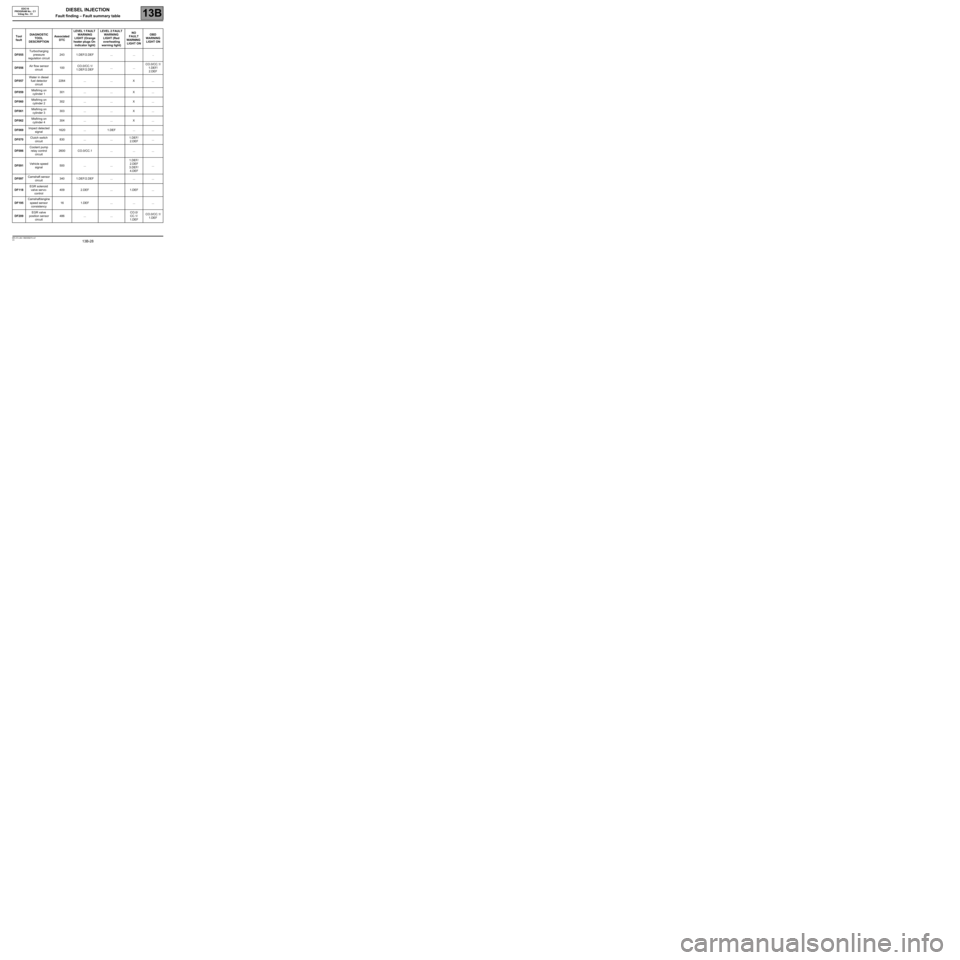
DIESEL INJECTION
Fault finding – Fault summary table13B
13B-28V3 MR-372-J84-13B250$270.mif
EDC16
PROGRAM No.: C1
Vdiag No.: 51
Tool
faultDIAGNOSTIC
TOOL
DESCRIPTIONAssociated
DTCLEVEL 1 FAULT
WARNING
LIGHT (Orange
heater plugs On
indicator light)LEVEL 2 FAULT
WARNING
LIGHT (Red
overheating
warning light)NO
FAULT
WARNING
LIGHT ONOBD
WARNING
LIGHT ON
DF055Turbocharging
pressure
regulation circuit243 1.DEF/2.DEF ... ... ..
DF056Air flow sensor
circuit100CO.0/CC.1/
1.DEF/2.DEF... ...CO.0/CC.1/
1.DEF/
2.DEF
DF057Water in diesel
fuel detector
circuit2264 ... ... X ...
DF059Misfiring on
cylinder 1301 ... ... X ...
DF060Misfiring on
cylinder 2302 ... ... X ...
DF061Misfiring on
cylinder 3303 ... ... X ...
DF062Misfiring on
cylinder 4304 ... ... X ...
DF069Impact detected
signal1620 ... 1.DEF ... ...
DF070Clutch switch
circuit830 ... ...1.DEF/
2.DEF...
DF086Coolant pump
relay control
circuit2600 CO.0/CC.1 ... ... ...
DF091Vehicle speed
signal500 ... ...1.DEF/
2.DEF
3.DEF/
4.DEF ...
DF097Camshaft sensor
circuit340 1.DEF/2.DEF ... ... ...
DF118EGR solenoid
valve servo-
control409 2.DEF ... 1.DEF ...
DF195Camshaft/engine
speed sensor
consistency16 1.DEF ... ... ...
DF209EGR valve
position sensor
circuit486 ... ...CO.0/
CC.1/
1.DEFCO.0/CC.1/
1.DEF
Page 29 of 273

DIESEL INJECTION
Fault finding – Fault summary table13B
13B-29V3 MR-372-J84-13B250$270.mif
EDC16
PROGRAM No.: C1
Vdiag No.: 51
Tool
faultDIAGNOSTIC
TOOL
DESCRIPTIONAssociated
DTCLEVEL 1 FAULT
WARNING
LIGHT (Orange
heater plugs On
indicator light)LEVEL 2 FAULT
WARNING
LIGHT (Red
overheating
warning light)NO
FAULT
WARNING
LIGHT ONOBD
WARNING
LIGHT ON
DF226Damper valve
circuit638CO/CC/CC.0/
CC.1/1.DEF/
2.DEF/3.DEF... ... ...
DF250ESP function C122 ... ...1.DEF/
2.DEF...
DF272EGR valve
control circuit403 1.DEF ... 2.DEF ...
DF276Injector code
programming611 1.DEF/2.DEF ... ... ...
DF485Catalytic
converter fault
finding422 ... ... X ...
DF532Alternator
charge signal2502CC.0/CC.1/
1.DEF/2.DEF... ... ...
DF619EGR valve
jammed open2142 X ... ... ...
DF620EGR valve
fouled2141 X ... ... ...
DF621EGR valve is
jammed open
(OBD fault)2413 ... ... X X
DF652Turbine
upstream
temperature
sensor circuit242A CC.0/CO.1
DF778Turbine
upstream
temperature
control242B 1.DEF/2.DEF
DF1070Cold loop 534
Page 30 of 273

DIESEL INJECTION
Fault finding – Interpretation of faults13B
13B-30V3 MR-372-J84-13B250$315.mif
DF001
PRESENT
OR
STOREDCOOLANT TEMPERATURE SENSOR CIRCUIT
CC.0 : Short circuit to earth
CO.1 : Short circuit or open circuit to + 12 V
NOTESConditions for applying the fault finding procedure to stored faults:
The fault is declared present:
–when an attempt is made to start the engine,
–when the engine is running.
Special notes:
If the fault is present:
–the coolant temperature: PR064 Coolant temperature is fixed at 119˚C,
–the preheating phase is greater than 10 seconds,
–the low speed motor-driven fan assembly (GMV 1) is continuously supplied,
–if there is a fault with GMV 1, then start GMV 2 for vehicles with air conditioning.
–the level 1 warning light is lit,
–the OBD warning light will illuminate after three consecutive driving cycles (starting
+ 5 seconds + switching off the ignition and waiting 1 minute).
Use bornier Ele. 1681 or Ele. 1590 for all operations on the computer connectors.
Check the connections of the coolant temperature sensor 4-track connector.
Check the injection computer connections.
Repair if necessary.
Measure the resistance of the coolant temperature sensor between tracks 2 and 3 of its black connector.
Replace the sensor if its resistance is not approximately:
75780 ± 7000 Ω at - 40˚C
12460 ± 122 Ω at - 10˚C
2252 ± 112 Ω at 25˚C
811 ± 39 Ω at 50˚C
283 ± 8 Ω at 80˚C
115 ± 3 Ω at 110˚C
87 ± 2 Ω at 120˚C
Check the insulation, continuity and the absence of interference resistance on the following connections:
Injection computer brown 48-track connector B
track F2Track 3 coolant temperature sensor
Injection computer brown 48-track connector B
track H1Track 2 coolant temperature sensor
Repair if necessary.
If the fault is still present, replace the coolant temperature sensor.
AFTER REPAIRDeal with any faults.
Carry out a road test followed by another check with the diagnostic tool.
EDC16
PROGRAM No.: C1
Vdiag No.: 51DIESEL INJECTION
Fault finding – Interpretation of faults
EDC16_V51_DF001